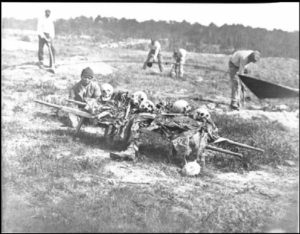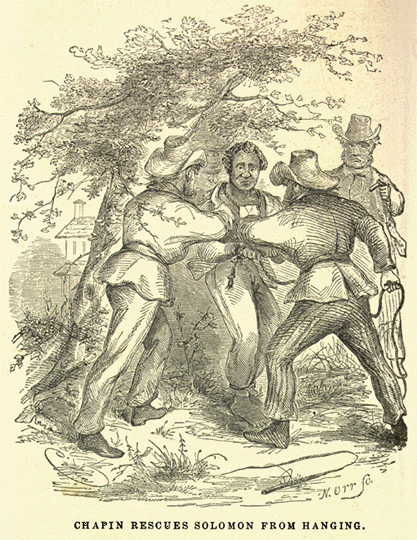Silent as the Grave
by Randall E. Auxier
 The first information I read said this was the Antietam battlefield, in a slave state after all, but not one in rebellion, so not subject to the Emancipation Proclamation, and hiring the freedmen to do this work. Maryland self-emancipated before the war ended. The workers were (it said) poorly paid (ex?)-slaves, or perhaps even actual slaves. They could be compared to the well-paid contractors who did the same work at Gettysburg. A lot of brown-skinned people dug a lot of graves, any way you look at it.
The first information I read said this was the Antietam battlefield, in a slave state after all, but not one in rebellion, so not subject to the Emancipation Proclamation, and hiring the freedmen to do this work. Maryland self-emancipated before the war ended. The workers were (it said) poorly paid (ex?)-slaves, or perhaps even actual slaves. They could be compared to the well-paid contractors who did the same work at Gettysburg. A lot of brown-skinned people dug a lot of graves, any way you look at it.
But then I read that perhaps these workers were “contrabands” working during the war, behind Union lines. Then I read that these were US colored troops, regulars, working after the war in a (messed up) effort to do something about the (messed up) battle sites outside of Richmond (including Cold Harbor and Gaines Mill). The most confident source says the picture was taken by a photographer from the studio of Matthew Brady at some portion of the Cold Harbor battlefield where bodies of Union soldiers were left unburied after the battle. Or, those pictured may have been from the much earlier battle of Gaines Mill on the same battlefield. No one knows. The timelines I read don’t make sense.
We do know that this picture is posed. There is a second image of just the stretcher, without the poignant presence of the young man. (Can you read his expression? I can’t.) The pictures are otherwise the same in angle and lighting. Some sources say the fellow on the high ground, stage left, is a white overseer, or a white officer. Some say these bodies looked like this after only four days, which is very unlikely. But we can see the image. No Photoshop back then. However posed, this was an actual scene somewhere.
I have been to the Cold Harbor/Gaines Mill Battlefield. Now most of it is covered by apartment complexes and residential developments (creepy place to live?). The (very Southern) attendant at the Visitors Center told me the “the Yankees” made no effort to preserve this place because they lost so badly here. But it doesn’t add up. What I see is a black man, whether soldier, contraband, or citizen, with the worst job there is. It wouldn’t be happy work under any circumstances, but least of all in his. So I asked my class: assume these are slaves. Are they singing the songs of the slaves that give rhythm to the work? Class: “No.” Emphatically, the class says. And if they are freedmen, do they sing? “No.” And if they are US colored troops, do they sing while they do this? “No.”
I am sure the class is right. But why?
To know the origin of American music requires that we learn the silence, the limits of the song. Where there is no singing, we must learn why in order to understand the space and time where it does appear. So the song is not here, in this scene (wherever it was). As awful as bondage is, and as profound as the desire to escape this world may be, the slave music is the sound of life, not of death. The place and time of death is silent, for us. So consider the silence.
I can hardly think of a better example than Arlington National Cemetery, which must be the quietest place in the country, apart from the lone bugle. It was not always so. This most sacred of ground was once the bustling plantation of Robert E. Lee. After refusing command of the Union Army, Lee evacuated his home, so close to the seat of Federal power. The Union cannily designated the plantation as a burial ground in 1864, for indigent soldiers whose families couldn’t afford shipment of the remains home. They were buried in a low place, near slaves and freedmen associated with the Lee family. But soon some Union officers were buried near Lee’s mansion (which still stands, of course). Unless I miss my guess, the earliest burial details were black men. And they didn’t sing.
In Gettysburg, Basil Biggs carried out the same duty with high level precision; a government contract was awarded to the African American farmer and businessman who owned Cemetery Ridge, where some of the worst fighting occurred. He was given a short time to disinter the shallow burials of July 1863 and re-inter them in the perfect rows of the new National Cemetery. It had to be done before the President arrived in November, where he would give a speech , ironically including that the world would “little note nor long remember what we say here.” We did though. This monument to the fallen was probably also created without the aid of song, and especially without slave song. Silence. The edges of slave song. The edges of American music.
But then there is the death song, isn’t there? The lament, the elegy, the dirge. Who sings it, and when? Deaths lamented in song need not be recent, but must be sung by those who are genuinely bereft. Otherwise it’s just a folk song, not a genuine lament. But who sings a dirge for the disinterred, the anonymous, the unknown and displaced soldier first-hand? No one really can. The essence of this scene is anonymity of the profoundest sort. Personlessness. I think of “The Three Ravens,” who discuss the corpse of the fallen knight, as dinner. We remove ourselves from the real meaning of such sacrifice by a thousand devices. Soldiers become graves and graveyards become flowers, and whether the “last full measure of devotion” (I read that somewhere) meets with anything beyond meaningless slaughter is a question we won’t answer soon. But the music, from “Johnny I Hardly Knew Ye,” to “One Tin Soldier” is passed down not as an object lesson, but as a question.
It is hard not to see in this scene the conversation between Hamlet and his Fool (or five fools, as this case may be). Both Crispin Sartwell and LeRoi Jones lay stress upon the extra-ordinary divide between masters and slaves regarding communication. Sartwell says that slave narratives and slave songs themselves are co-opted into the brutal system: “To enslave and silence you is to disempower you, but to allow you to speak is to empower our [white] selves. That you speak at all integrates you into the symbolic realm that is conceived as our [white] exclusive domain . . . that we dominate your speech reconfigures the symbolic as again our [white] domain.” (Act Like You Know, p. 23) This must have been what Frederick Douglass (whom, I hear, has done an amazing job) felt like when invited to speak about the meaning of July 4th to a slave. Even among abolitionists his famous speech must have been shocking. Perhaps they expected a polite wind-up toy. After all, as Jones puts it, “if you twist the knob on your radio you expect it to play.” And below we can see what happened to the slave who insisted he wasn’t a machine. He isn’t singing either.


